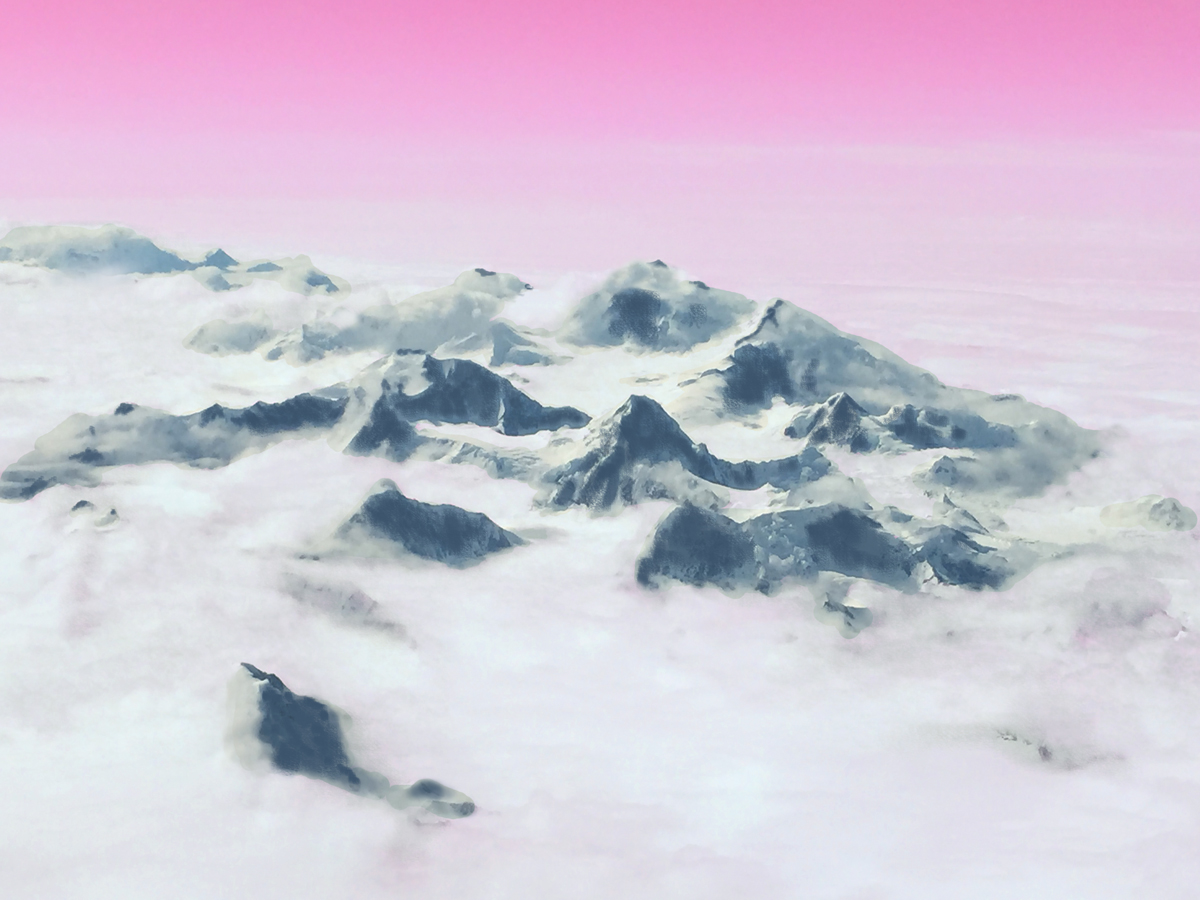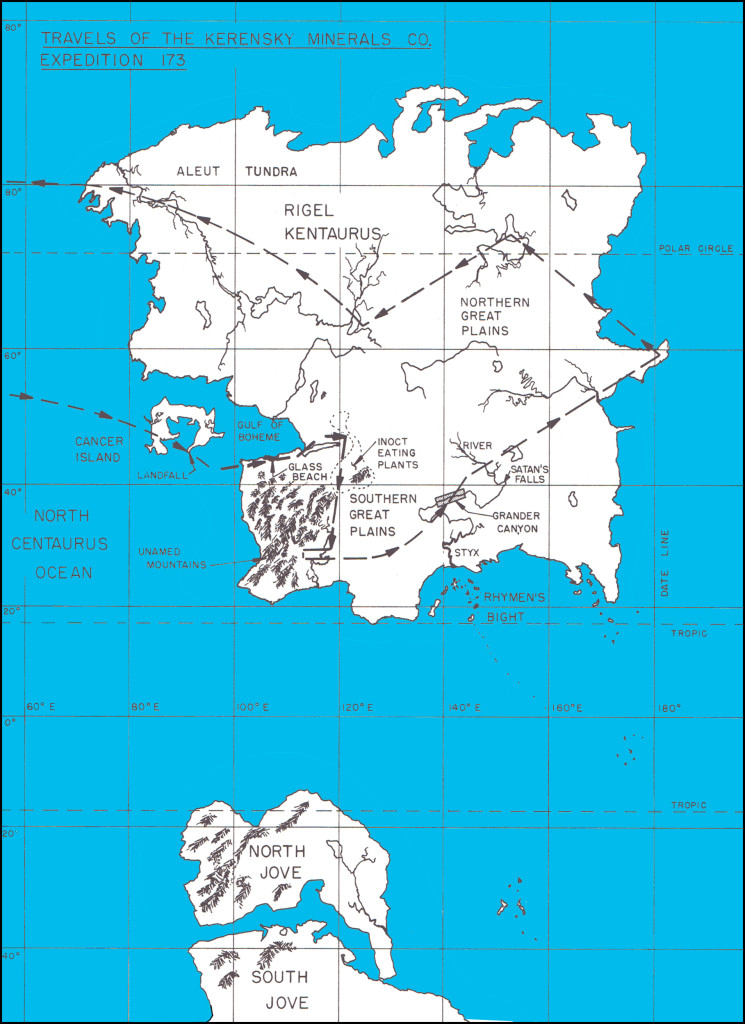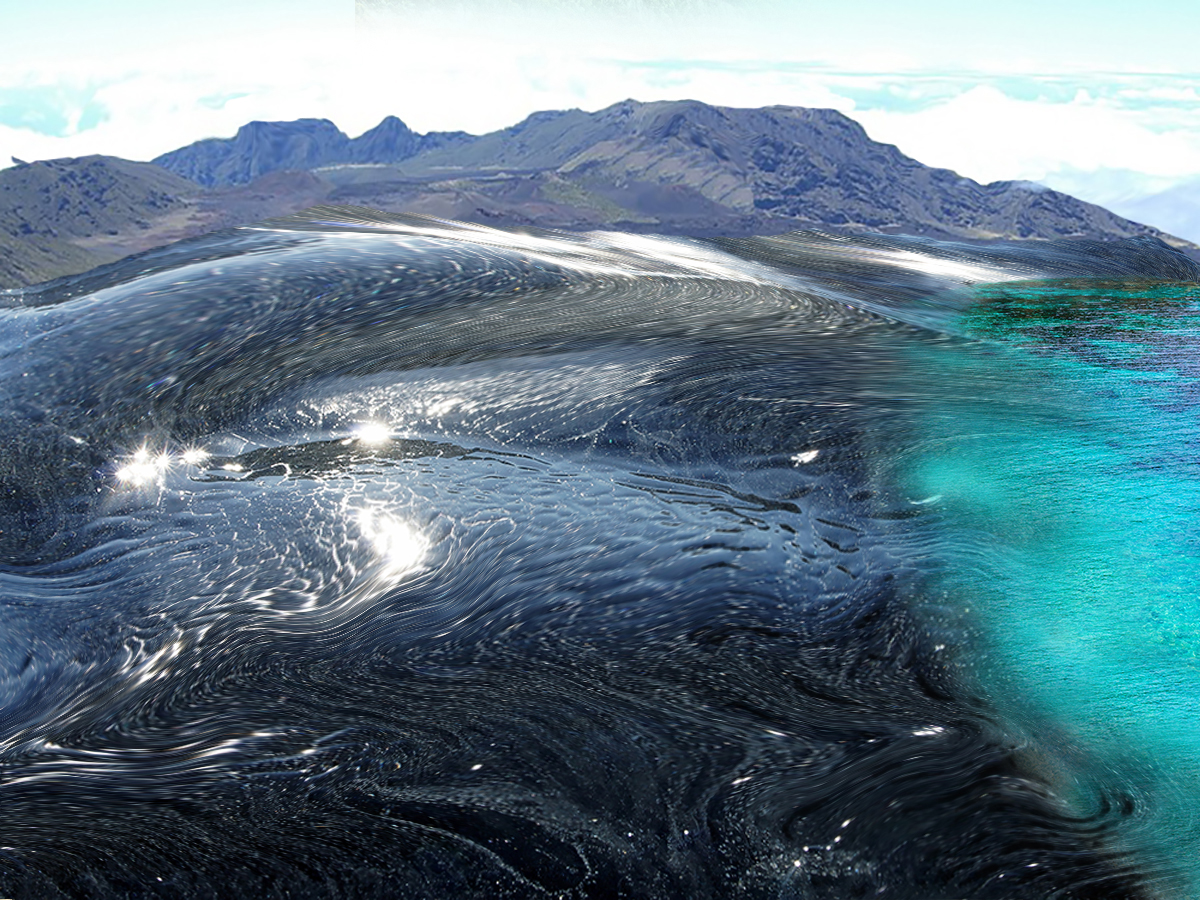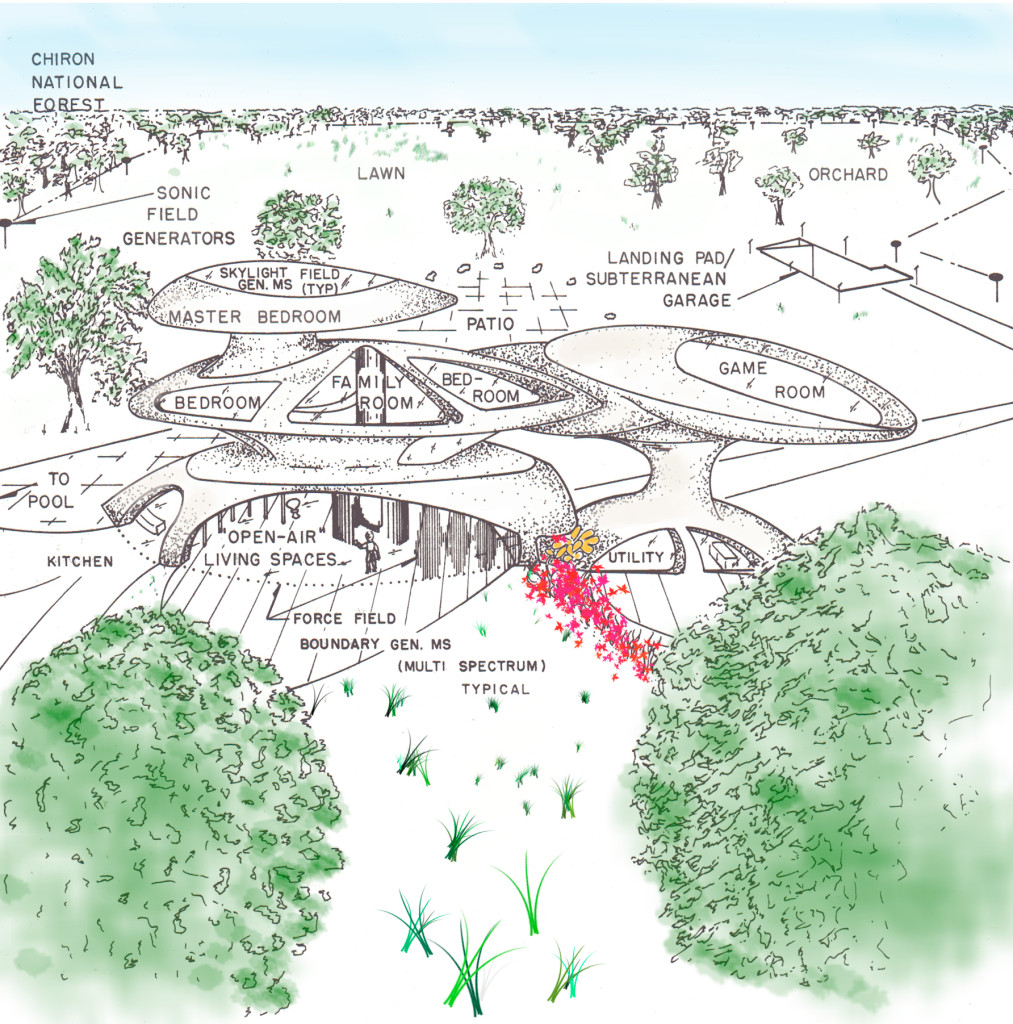ACCOUNT OF LIFE ON WYZDOM
Editor’s Note: Alex Kotorovich, 43, Director of the New Georgia Bauxite Recovery Operation and Mayor of New Georgia, gives an account of life on Wyzdom. A native, born of immigrant parents, Alex moved with his family to New Georgia and became acclimated to the higher atmospheric pressures at age 13. He took his Bachelor of Science Degree in Geology from the Wyzdom University College of Science, then went to work for the Kerensky Mineral Development Company as an exploration geologist and spent nine years as part of a mineral survey team. The team explored much of Wyzdom’s uninhabited land mass, making detailed surveys of mineral deposits. During his travels, Alex saw much of the new planet that Human eyes had never looked upon. His personal observations, taken in the form of copious notes and pictures, formed the basis of his textbook on Wyzdom’s physical geography, which remains the definitive work on this subject today. After his travels, Alex returned to New Georgia, where he resides today with his family. His experience as an explorer; a civic leader and a professional author makes him eminently qualified to write of life on his home planet.
I have never been to Earth, though I am Human. My ancestry dates back 100,000 years to the first homo sapiens that stood erect, yet in another sense I form the first of a new species. With my kind begins the evolution of homo wyzdom, a different being adapted to a different world.
As I emerged from the womb, my first breaths drew thin air much like Earth’s, for my birthplace, the Jan Plateau, lies in the rarified atmosphere 4600 meters above the sea. I found learning to walk a painful experience, for Wyzdom’s high gravity is unforgiving of the mistakes of children. Falls come fast and hard. Yet I survived and grew, and my muscles acclimated to the stronger pull of our world. My legs grew thick and my back broad and strong. Today, my proportions make even my Ukrainian parents seem slender by comparison. The first major event of my life occurred at the age of 13, when my father announced we would be moving to New Georgia. The Lowlands! In my early years I was not an adventuresome child. Few people lived in the lowlands then. They were thought of as wild and dangerous places, far from the civilization of the Plateau. Rumors abounded of giant storms that leveled whole villages and of giant birds that carried people off whole to devour them in their lairs.
My father is not disposed to argue, especially with his children. The job that awaited him at the new organochem complex offered a monumental leap for his career. For us there would be more money, more land, a large new home, and college educations that he never had. Our howls of protest fell on deaf ears. We packed our belongings and moved.
My mood changed from petulant depression to awe and wonder as we streaked across Chiron on the hypergrav. From my vantage point 30,000 meters up, beneath a purple sky, all of the continent’s great natural features passed in review. The green forests of the eastern Plateau ended abruptly in great cliffs dropping away to the maze of ridges of the upper Dostov River. Then the Allahm Mountains rose before us. When I asked my father the difference between a mountain and a hill, he replied, “A mountain makes your palms sweat when you stand at the bottom and look up at it.” He had seen the Allahms before. Most large mountains have a timber line, above which vegetation cannot live, and their tops are capped with snow. The Allahms are so tall that a second line appears, above which no snow can fall! Their great rock crowns thrust out of white mantles of perpetual snow; giant guardians of our planet’s treasures.

Figure 3.2.003 – Aerial Image Allahm Mountains – Chiron Wyzdom
The hypergrav swooped down from the western slopes of the Allahms into the port of Kerenberg, and from there slower antigrav cars carried us to the bustling- construction camp at the plant. The first months in the camp dragged interminably. There was little to do except read or organize impromptu field games with the other children. Our parents took note of this and began to organize a school to continue the educations that most of us interrupted when we moved. In those days, educational terminals were nonexistent in the province. A few parents had teaching experience and took it upon themselves to use one of the general access terminals after business hours to read and memorize a lesson to present to the children the next day. This was the rude beginning of a tradition of voluntary education that continues to the present in New Georgia, although now ample teaching facilities exist and most children have their own terminals. During those early months, Mother poured through the prefab catalogs, picking out a house for us. On weekends when father could get away, he took us over the surrounding wilderness for hundreds of kilometers in every direction looking for the perfect homesite. In those days, personal land claims in the lowlands could total ten hectares.
We soon settled on a gently sloping hillside at the edge of a large lake. A forest of short, evergreen trees covered the countryside around our new home. Most of them bore green compound needles. I called them “Christmas Balls” because each needle consisted of a circle of needles, each bent from its root to its tip and connected again to form a tiny, green cage.
Since deliveries on modular homes ran to three months in those days, Father decided we should clear the land for the house ourselves. Each weekend he gathered up the entire family and we flew to the homesite for a weekend of work. Father rented a large laser cutter/disintegrator and a couple of antigrav “skyhooks.” One by one we cut down enough trees to make a circular clearing 40 meters in diameter. We used the skyhooks to move the logs to a great pile so the wood products company could pick them up, then burned out the stumps with the disintegrator beam. We worked very hard, even though machines did most of the physical labor. It was very satisfying to see our progress each weekend. At night mother cooked outdoors, and we slept in a temporary dome in the clearing. It all seemed like a great adventure.
Since the first day in the lowlands, my parents admonished us not to wander off alone, and to always carry our ultrasonic generators to repel the great predatory birds. These creatures never appeared near the organochem plant, perhaps because the noise and bustle of the construction frightened them, but on the second weekend at our wilderness homesite, I made the first of many encounters with these magnificent beasts.
Father had just cut a large tree, and we were in the process of stripping branches and attaching antigrav hoists so we could move it to the log pile. Suddenly an enormous shadow flashed across the clearing, and all heads turned upward to see a giant bird circling overhead. Its wings spanned nearly six meters, and an awful head, armed with a jagged, hooked beak protruded between them. As it circled, the sun glinted off its brilliant plumage which varied from forest green on top to pale sky blue beneath. Golden feathers covered its head like a helmet, in contrast to its blood red beak and feet.
Upon seeing the bird, Father ran to get his laser rifle, and the rest of us scrambled for our sonic guns. After circling the clearing a few more times, the bird alighted near us and began to approach on foot, walking awkwardly but deliberately on its stubby legs. It stood about 1.5 meters tall and appeared more curious than hostile. My adrenalin surged, and my heart pounded as I looked from the bird to my father and back. None of us had ever confronted such an animal before, and we didn’t know how dangerous it was. The bird and my family faced each other for several long moments, when suddenly, as abruptly as it came, it turned, leaped into the air, and streaked across the clearing to snatch a smaller bird about the size of a chicken from midair. It continued up over the tree tops, clutching its prey, and soon disappeared from view. The instant it vanished, we all burst out talking at once, and the bird consumed our interest as we worked for the rest of the afternoon.
My teens passed quickly in New Georgia. Despite the informality of our school, I learned enough by age 17 to pass the entrance exam for the Wyzdom University at Hadar. Despite my interest in biology, I majored in geology because I thought it would help me to get a better job. By graduation, my emotional and intellectual horizons had broadened, and I yearned to see more of my fabulous world. I accepted an offer to become an exploration geologist and thereby began a ten-year adventure that took me over four continents.
Wyzdom’s crust is quite poor in the heavier industrial metals, such as chromium, copper, iron, lead, nickel, and zinc. Even the lighter structural metals, aluminum, titanium, and magnesium, exist only in very low-grade deposits. Because of the scarcity of transportation, early pioneers used the poor deposits of the Plateau, but as the population spread out and the capacity to build transports grew, Wyzdom’s mine operators began looking far and wide for potential mining sites. Satellites and shuttle flys give valuable information about the probability of finding useful ore deposits, but only old-fashioned drilling and sampling methods can prove that commercially minable deposits exist. My first trip out as a fledgling geologist took me to the western foothills of the Allahm Mountains in southern Chiron. There, the same geologic forces that created the mountains pushed up iron and nickel deposits of minable quality. We traveled in a convoy of low flying levitrucks which provided living quarters for the crew as well as carried surveying and drilling equipment. Going out we flew directly south of our base on the Jan Plateau, passing into a broad flat region covered by dense, tropical forest.
Though these were winter months, temperatures ranged into the low 30s and it rained daily. As in most lowlands, the forest trees were short and thick, though some long and slender species resembled giant field grasses. These strange plants grew in patches, driving out the broad-leafed, low trees beneath. They sported bright white or purple structures like pom-poms at their tops. Though they ranged up to 20 meters in height, their trunks varied between 10 and 20 centimeters in diameter, and they could bend up to 90 degrees in strong winds. Over most of the plains and foothills, vegetation lay so thick that we couldn’t land without burning a small clearing. Despite the fact that our laser defoliators stripped the ground bare, the vegetation grew to more than a meter tall again within a week. The southern plains may someday serve as incredibly productive farmland if people can learn to cope with their unrelenting heat, violent winds, and prolific natural vegetation.
The next five years took me to the four corners of the Chiron continent; from the southern rain-forests to the central deserts ruled only by giant inocts, to the frozen tundra in the north where the wombat moles bore their intricate mazes hundreds of meters beneath the surface. Despite great variations in climate and life forms, gradual transitions separated one biome from the next. When my exploratory missions began to take me to other continents, I saw startling changes from what I had known on Chiron.
In those days Vladimir Kerensky still ruled Kerensky Minerals Company with an iron hand. His business genius lay in his ability to sense an economic need long before most people began thinking about it. He reasoned that people would live in the pleasant climates of the uninhabited continents of Jove and Rigel Kentaurus long before they occupied the tropic regions of Chiron. When these pioneers moved to new continents, they would need minerals and Kerensky would already have located the best deposits and made plans for mining them. To this end he dispatched me to lead an exploratory team to Rigel Kentaurus, and for much of the trip we penetrated virgin country. As part of our duties, Kerensky wanted us to observe and photograph the landscape, to classify interesting and potentially dangerous life forms and to make weather observations in addition to our usual surveying and sampling tasks.
To get to Rigel K, we had to cross the North Centaurus Ocean. We traveled in extra large levitrucks designed for these missions. Even at our cruising speed of 800 kilometers per hour, the ocean crossing took more than 14 hours. In midwinter, great storms sweep the North Centaurs.
Winds reaching nearly 300 kilometers per hour drive giant waves to heights of 30 meters. Because of Wyzdom’s high gravity, such waves pack more energy than comparable waves on Earth, and therefore travel much farther after they leave the storm area. Even in calm winds, the winter ocean remains restless. During the trip we passed through one great storm, flying high, surrounded by a wall of grey clouds. When the weather cleared, we skimmed the water just above the waves, hoping for glimpses of interesting sea creatures. At such high speeds, we didn’t have much luck, but we did catch sight of a “Buffington’s swimmer,” a large, cold-blooded water-breathing animal, shaped somewhat like the Earth’s extinct Plesiosauria. All across the sea, long winged birds, resembling enormous versions of the Earthly albatross, crossed our path, occasionally dipping into the sea for food.
The map of Rigel Kentaurus (Figure 3.3.001 below) shows the path of our journey. We crossed the coastline at 43 degrees north latitude and headed northeast along the shore of the Gulf of Boheme. We soon came upon the most unusual coastal formation I have seen, a beach made of solid black glass (Figure 3.3.002 below). The view from the air was so extraordinary that we stopped to have a look. In shape the beach looked like any other sand beach, but instead of sand, it consisted of a solid sheet of jet black glass, slightly rippled, but overall, remarkably flat and smooth. The black tint, apparently caused by a variety of trace elements, prevented us from seeing far beneath its surface, but I could discern many small air bubbles trapped in it, indicating that it was a natural formation. Closer inspection of the landward edge revealed a giant fissure which long ago had flowed hot lava, a sort of linear volcano five kilometers long. Apparently the glass flowed from this crack and cooled, but many unanswered questions remain. Why didn’t the glass shatter upon contacting the water? Why hasn’t the ocean eroded it into sand? How did it happen to flow so evenly and smoothly?
Figure 3.3.001 – Map of Rigel Kentaurus Wyzdom
Figure 3.3.002 – Glass Beach of Rigel Kentaurus Wyzdom
With the strangeness of the glass beach lingering in our minds, we pressed on to the northeast, rounding the northern edge of a large unnamed mountain range that dominates the southwest quadrant of the continent. In the mountains’ foothills, along the edge of a great plain stretching to the opposite shore, we began our search for minerals. Immediately, we began to notice important, but subtle differences in the basic structure of Rigel’s plant life. Gone were the compound needles and broad leaves of Chiron, and in their place grew leaf structures more reminiscent of Earthly ferns. Further south lay forests of inoct-eating plants that devour their prey like Earth’s Venus’s flytrap. Unlike the flytrap, however, these partially carnivorous, partially photosynthetic plants live in large groves. We couldn’t imagine how such large numbers of plants could exist without decimating their inoct food supply, but several years later biologists noted that the inocts consumed by the plants were scavengers, thriving primarily on decaying leaves dropped from the trees. Thus, like all things in nature, the inocts and the trees formed a continuous, self-renewing process wherein neither one could exist without the other. The birds of Rigel Kentaurus fascinated us even more than the plants, for they did not bear feathers but wore instead a light coating of fur. Their wings consisted of skin stretched across complex arrays of bones and their heads bore bird-like beaks containing rows of jagged teeth. They flew quite well in the heavy air, though they did not glide as well as their feathered counterparts on Chiron.
The Styx River traverses the south Rigelian plain, meandering like Earth’s Mississippi. The river basin is one of the well-explored regions of the continent. The first Humans set foot there during the second exploratory expedition more than 285 years ago. Although commercially of little interest, the river has formed one of the largest and most beautiful canyons in the Human worlds, dwarfing Earth’s Grand Canyon and matching the intricacy of its formations. As geologists, all of us itched to finish our work and then see this great natural wonder.
We crossed the plains, arriving at the canyon’s edge during the night, and waited until the next morning for a good view. Since the forest runs right to the canyon’s edge we camped in a clearing a kilometer away. The next morning, after an early breakfast, we set out on foot for the canyon rim. Little had prepared me for the view we found. Beyond the edge, the world seemed to drop away.
All perspective was lost amidst the great valley spreading below us. Within it, huge columns of rock rose singly, in great arches and in buttresses against the canyon’s walls. Unlike Earth’s Grand Canyon, this Grander Canyon lies in an area of heavy rainfall. Green foliage clings to the walls and rock outcroppings, though as the sun rose, we saw that many of the sheer rock walls were exposed.
The magnitude of this formation cannot be appreciated fully from the canyon’s edge. Indeed, we didn’t have a complete view of it until we took our levicars almost two kilometers above the rim. Later in the day, we hovered next to the sheer walls, examining the different strata that contain a record of much of Wyzdom’s history. Someday many geologists and paleontologists will spend their lifetimes studying the important records of the canyon which will help piece together a history of his planet.
In this space I can recount but a few of the many experiences of discovery I had during my years as an explorer; the attack by a pack of Jovian griffins, the largest of the planet’s flying predators; the eruption of Mt. Isis, largest volcano on the – planet, which dwarf’s Earth’s Mauna Loa; the exploration of Fairbank’s caverns, extending for 20 kilometers beneath the south Jovian plains. Yet after ten years in the field, I felt a desire to settle down. I transferred from exploration to the company’s operating division and once again found myself in New Georgia. The province had grown populous enough to justify opening a bauxite mine, an aluminum refinery, and a shaping mill. I entered the project early, performing the detailed preconstruction drilling and analysis necessary to design day-to-day mining operations. As the project unfolded, I learned more and more about the mining business, until over the next decade I worked myself into the position of Director of Bauxite recovery operations at the Koppernick River Complex. I am now responsible for every aspect of mine operations, from taking ore out of the ground through transporting it to the inlet of the adjacent refinery.
Since ending my career in exploration, I have indeed “settled down.” My wife, Sonja, and I are raising our children, and we own a commercial orchard. I am an elected public official and manager of a large company. Though settled, life seems far from static to me. New Georgia encompasses an area about half the size of Europe on Earth. When my parents first moved here, it contained less than 300,000 people. When I returned from my world travels, 1.2 million people lived here. Today the population has again more than doubled. The principal city of Kerenberg has grown from an outpost to a major metropolis and the province that once had to import virtually all consumer and industrial goods now boasts many major industries. Life in the region is changing and diversifying so rapidly that, though I’m staying still, I often think I’m traveling around the world, living in a new community each year. Sonja and I actually have more freedom to travel when and where we want to than we did when we were younger, but we have the advantage of feeling that we are a part of a local community too.
My home has a 40 hectare commercial claim next to it where my wife operates a profitable citrus orchard. We’ve left a strip of virgin forest between our house and the “farm,” so Sonja can forget about it when she wants to. Our house (figure 3.4), like most other rural houses, is constructed from modular housing components flown in by levitruck and stuck together like giant branches on an artificial tree. Like modern houses on Earth, ours has full spectrum force field walls that keep out dust, cold, and intruders, yet can be adjusted in intensity to admit light or fresh air as desired. Though the structure is built to withstand strong earthquakes and the high forces of lowland winds, a ring of native trees around it provides an extra safety factor by serving as a windbreak. The low density of dwellings in most parts of the Province makes central water, power, and waste disposal systems impractical. Water comes from our own well, and waste water is treated and used on our garden and orchard. We compost organic wastes and save recyclable trash in a large storage bin that the recycling company collects each month. All else we burn in our smokeless plasma incinerator. The whole process is automated and concealed underground.
Power comes from our laser fusion reactor that uses heavy water as fuel. We consume about a liter per month, delivered quarterly by the service company that maintains our power plant. Our communication link with the outside world is via satellite through our roof-mounted antennae. It provides a channel for videophone, recorded correspondence, news, weather forecasts, entertainment, books, computing service, banking, computer lessons, and catalog shopping. Like many Provincials who grow much of their own food, we shop for the many grocery items that are processed or can’t be grown here through a remote order system. Our groceries are then delivered by a robot levitruck that regularly covers our neighborhood.
Because people are spread so thinly on Wyzdom, neighbors don’t seem to get on each other’s nerves. Physical contact can be avoided unless a person wants it. Perhaps because of this, Wyzdomites are highly tolerant toward each other’s life styles. Even on the Jan Plateau, the most densely populated area of the planet, few universal standards of moral, social, sexual, or religious conduct are held. Family organization ranges from homosexual hermits through nuclear families to large communal families encompassing up to a dozen adult men and women and several dozen children.
Physical proximity does not link communities on Wyzdom as much as do common interests, friendships, and lifestyles. Groups of people drawn from hundreds of kilometers in all directions often undertake, projects of common interest, such as building an athletic center or a lake, or operating a school of their particular design.
Figure 3.4 – The Kotorovich Family Home
New Georgia, Chiron
Chiron National Forest
I, myself, am a member of several communities: Legally, I’m a resident of the New Georgian Province and active in its politics; professionally, I am a miner; socially, my family and children form an important part of my life, so I am part of a community of parents that operates a cooperative school along traditionalist principles; and finally my family is active in sports, so we are members of the Pan Wyzdom Track, Field, and Swim Association.
All of us participate in competitive events and games that could culminate in a planet-wide contest of champions. Many of our sports trace their origins to Earth, but Wyzdom’s high gravity and, in some instances, the high atmospheric pressure, change the dynamics of the games and therefore their strategies. Wyzdom’s track and field statistics appear unimpressive alongside Earth’s, but in swimming contests, where the effect of gravity is reduced, athletes of Earth wouldn’t stand a chance.
I currently serve as “mayor” of the Provincial Government of New Georgia. A province is a rather vague governmental body, sandwiched in between highly localized “commonwealths” and the larger planetary government. The Province operates local police patrols and has original jurisdiction over minor crimes, such as burglary, petty theft, and minor environmental pollution. It may not make any laws abridging the rights enumerated in the planetary constitution, but it makes a variety of laws of local interest, and it administrates provincial land claims in accordance with general policies created by the planetary government and GAILE. Some people in well-defined geographic areas have created local commonwealths to provide more service and protection than the Province offers. Industrial groups, such as the West Koppernick Electronics Complex, and commercial groups, such as the City of Kerenberg, as well as groups of individuals have formed legal commonwealths. These perform all the functions within their areas that the provincial government would perform.
As mayor of New Georgia, I chair the seven-member Provincial Council, the elected legislative and executive body of the Province. My job consumes only 10 to 15 hours of my time per week, for I am not actually an administrator. I leave day-today government operations to five full-time, salaried officials: Chief of Police, Provincial Prosecutor, Chief of Administration, Provincial Judge, and Liaison to the Planetary Government. I act as a reviewer and final authority, as well as a lawmaker. To discourage “professional” politicians, no person may hold a position or be elected for more than one term, and I will be relieved when mine is over.
Wyzdom’s growth during our first century has been slow and sometimes painful. The cost and complexities of space travel in our first century served as the principal barriers to large-scale migration, but now, with the most difficult years behind us, we stand poised to make great strides in learning and industry which will benefit all intelligent life. As an advanced, highly industrialized society, Wyzdom offers the conveniences of life on Earth; yet Wyzdom has lost neither the frontier’s sense of adventure nor the friendly intimacy of a small community. We welcome to our young planet all people who are willing to work hard for themselves and to enjoy life with us.



